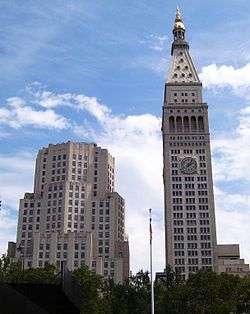Metropolitan Life North Building
| Metropolitan Life North Building | |
|---|---|
 | |
| General information | |
| Location | 11-25 Madison Avenue, Manhattan, New York 10010 |
| Coordinates | 40°44′29.6″N 73°59′11.6″W / 40.741556°N 73.986556°WCoordinates: 40°44′29.6″N 73°59′11.6″W / 40.741556°N 73.986556°W |
| Construction started | 1928 |
| Completed | 1950 |
| Height | |
| Roof | 137.5 m (451 ft) |
| Technical details | |
| Floor count | 30 |
The Metropolitan Life North Building, now known as Eleven Madison, is a 30-story art deco skyscraper on Madison Square Park in Manhattan, New York City, at 11-25 Madison Avenue. The building is bordered by East 24th Street, Madison Avenue, East 25th Street and Park Avenue South, and is connected by an elevated walkway to the Met Life Tower just south of it. The North Building was built on the site of Richard Upjohn's original Madison Square Presbyterian Church. The second church, designed by Stanford White of McKim, Mead and White was built in 1906, across 24th street on land conveyed by Metropolitan Life. As part of the Metropolitan Life Home Office Complex, the North Building was added to the National Register of Historic Places on January 19, 1996.[1]
History
The Madison Square Presbyterian Church, designed by Richard M. Upjohn in the Gothic Revival architectural style, was located on Madison Square Park at the southeast corner of East 24th Street and Madison Avenue, and was completed in 1854.[2] The building was acquired by the Metropolitan Life Insurance Company to make way for the 48-story Metropolitan Life Insurance Company Tower. In exchange, the church received a 75' by 150' plot of land across 24th Street that became the site for Stanford White's Madison Square Presbyterian Church, sometimes called the "Parkhurst Church" after Reverend Charles Henry Parkhurst. Upjohn's building was demolished in 1909.

The North Building was designed in the 1920s by Harvey Wiley Corbett and Dan Everett Waid[3] as a 100-story skyscraper that would have been the tallest building in the world. However, due to the Stock Market Crash of 1929 and onset of the Great Depression, the construction was halted at floor 29 in 1933.[4] Metropolitan Life had originally planned to have a 100-story tower, and the existing building was constructed to be strong enough to support extra floors. Still, when construction was completed on the 25-story "base" in 1950, there were no plans to build the extra stories.[4] The original plans were to include an entrance to the 23rd Street subway station, but the entrance was ultimately built one block south, on 23rd Street, with an entrance through the Metropolitan Life Insurance Company Tower at One Madison Avenue.
The building, which has 2,200,000 square feet (200,000 m2) of space,[3] was constructed in three stages,[3] and was finally completed in 1950. It is finished on the outside with Alabama limestone and marble detailing, and marble in the lobbies. The building features four vaulted corner entrances,[5] and its bulk is mitigated by numerous setbacks[3] and its polygonal shape.[5] The building contains 30 elevators, enough to serve the originally-planned 100 floors.
From 1994–1997, the building, which has served time as Met Life's records warehouse,[5] had its interior redesigned by Haines Lundberg Waehler and the exterior renovated, all at the cost of $300 million.
Current occupancy
11 Madison Avenue is owned by the Sapir Organization. The primary tenant is Credit Suisse, with Yelp, Inc. and Sony Corporation of America as notable additional tenants.[6][7] The restaurant Eleven Madison Park is at street level on the Madison Avenue side of the building.[3]
In popular culture
- The 1981 thriller Eyewitness used the building's lobby as the place where William Hurt's character was employed as a janitor, and where the brutal murder that begins the film takes place. Other scenes from the film were shot there as well.[8]
- Director Martin Scorsese used the building as the location for Griffin Dunne's office in the 1985 film After Hours.[8]
- Woody Allen's 1986 Radio Days utilized the North Building for the building where the offices of a broadcasting network were located.[8]
- Slick Rick's 1998 album The Great Adventures of Slick Rick features a photo of the building on its cover.
- In the 2011 film The Adjustment Bureau, the building's lobby is used as a setting for some scenes.
- Kim Stanley Robinson's book New York 2140 is centered on characters living in and around the building.
- In the 1991 film The Fisher King, the main character's love interest works at the building.
See also
References
- ↑ National Park Service (2007-01-23). "National Register Information System". National Register of Historic Places. National Park Service.
- ↑ Moudry, Roberta. The American Skyscraper: Cultural Histories (2005 ed.). Cambridge University Press. ISBN 978-0-521-62421-3. , p.125
- 1 2 3 4 5 Mendelsohn, Joyce (1998), Touring the Flatiron: Walks in Four Historic Neighborhoods, New York: New York Landmarks Conservancy, ISBN 0-964-7061-2-1, OCLC 40227695
- 1 2 Gray, Christopher (May 26, 1996). "Streetscapes: Metropolitan Life at 1 Madison Avenue; For a Brief Moment, the Tallest Building in the World". The New York Times. Retrieved November 10, 2015.
- 1 2 3 White, Norval & Willensky, Elliot (2000), AIA Guide to New York City (4th ed.), New York: Three Rivers Press, ISBN 978-0-8129-3107-5
- ↑ https://commercialobserver.com/2017/08/yelp-expands-nyc-office-11-madison-avenue/
- ↑ Delaporte, Gus (24 February 2014). "Sony Makes 11 Madison Avenue Deal Official". Commercial Observer. Retrieved 29 December 2015.
- 1 2 3 Alleman, Richard (1988), The Movie Lover's Guide to New York, New York: Harper & Row, ISBN 0060960809 p.160
External links
| Wikimedia Commons has media related to Metropolitan Life Insurance complex. |
- in-Arch.net: The Metropolitan Life Insurance Co. Building and Annex
- Original building design at Skyscraper Page
- Design of finished building at Skyscraper Page